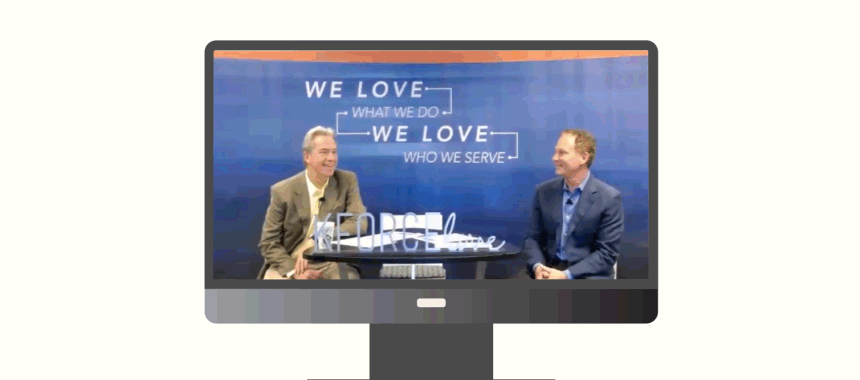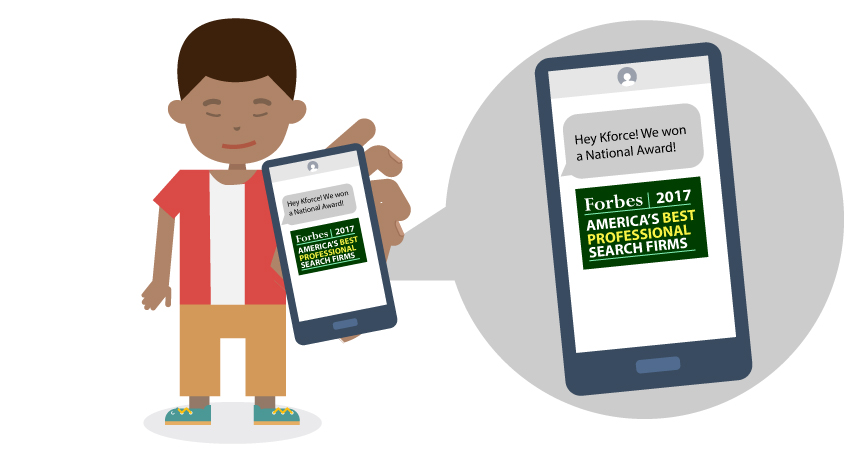
PUBLISHED OCTOBER 20, 2017
5 Internal Communications Tactics to Boost Employee Morale
On my first day as the communications manager at Kforce, a colleague told me not to overthink my job because no one reads corporate emails.
That was the best thing he could have told me because it inspired me to prove him wrong.
For the past eight years, I’ve been dedicated to ensuring that employees not only read our communications but look forward to them and – most importantly – act. I’ve created an acronym, S.M.A.C.K., which describes a few pillars of my strategy which includes transparency, technology, targeted audiences, the need for elements of surprise and flexibility. 
Effective communication with our employees is paramount to succeeding in any industry. Failure in this area has many consequences, including threatening our bottom line.
When we fail to engage our employees, we risk losing them. Only 33 percent of U.S. employees are engaged in their job, and slightly more than half (51 percent) say they are actively looking for a new job or watching for openings. And most employers know that having an empty chair is expensive – costing up to 250 percent of their annual salary and almost one month’s time.
That’s why it’s important to hook employees while you can. Get their attention and keep it. If employees understand the company’s vision and feel as though they contributed to its success, you’re less likely to watch them leave. There’s a reason why “being transparent” is a popular goal for companies today. It means something not only to millennials but people of all ages.
There’s a reason why “being transparent” is a popular goal for companies today. It means something not only to millennials but people of all ages.
My daughter just entered kindergarten, and she comes home every day talking about the Golden Rule. That mindset never changes – it’s always a good practice to tell the truth.
Be transparent about the direction your company is going. What’s your strategy? Are you succeeding? What should change to increase your chances for success? These things matter to your employees, whether they’ve been there for one day or ten years.
Be timely. Don’t wait until after a major incident to speak up. Our company holds live, national webcasts just hours after our quarterly earnings calls. This allows our President and CEO to discuss challenges or celebrate wins in a timely manner. Research shows that teachable moments only happen when they’re specific and immediate, so why wait months before communicating the company’s ups and downs? There will be no chance for employees to turn it around.
It's also important to ensure you’re casting a wide net by speaking to all levels of the company, not just those in management.
I tend to get nervous on flights, but I always feel better once the captain comes on the loudspeaker and shares his flight plan – how high we are, the direction we’ll be flying, and approximately when he expects to land. It’s even comforting when he warns us about turbulence – at least you know he’s one step ahead of the storm.
As an employee, you’re seated “with your seatbelt securely fasted.” You can’t see what’s happening in the cockpit, and most likely you haven’t met the pilot. How comfortable can you feel being “flown” blindly year after year? That’s why it’s important to share your company’s mission – not only to your trusted leaders or your most tenured employees but also to your new hires, the support staff and anyone who contributes. They need to know where they’re going, and that you have a plan to get there. It will prove to be a smoother ride for all.

Why are we still heavily relying on email when we all know it’s the last thing people read? Stats show us that people browse websites, view video and swipe through digital magazines more often than reading lengthy newsletters. I mentioned the webcast we produce. It has allowed us to communicate a consistent message to a dispersed workforce in seconds. Our feedback has been tremendous and has even affected the business by connecting groups that hadn’t worked together before. And that’s what you want.  In the last year, we’ve also embraced digital signage, and it’s changing how we communicate. With 63 offices nationwide and a fast-paced industry with busy employees, it’s challenging to not only get our associates’ attention but to do so quickly and effectively. By having a centrally controlled, cloud-based system, we can release short, visual messages to each of the TVs located in our team’s offices. Employees have told us how much more connected they feel to the overall mission of the company. It’s not only made our firm feel smaller, but it’s also created a sense of teamwork we’ve never had before.
In the last year, we’ve also embraced digital signage, and it’s changing how we communicate. With 63 offices nationwide and a fast-paced industry with busy employees, it’s challenging to not only get our associates’ attention but to do so quickly and effectively. By having a centrally controlled, cloud-based system, we can release short, visual messages to each of the TVs located in our team’s offices. Employees have told us how much more connected they feel to the overall mission of the company. It’s not only made our firm feel smaller, but it’s also created a sense of teamwork we’ve never had before. 
Technology today also provides an opportunity to track your success more than ever before. By incorporating metrics into everything you do, you can easily tell if a communication tool was effective. Reporting can be done by leveraging email marketing tools to track open and click rates, embedding tracked links into a document or adding polls into emails. And over time, analytics will show trends and lead to a newly revised strategy for your Firm.
A few years ago, our company struggled to define our audience properly (more to come in my next point) and sent all emails to all employees. By using analytics, our team proved that by minimizing mass emails and targeting audiences appropriately, we could save an average of 1,542 working hours, increase our average open rate to 80 percent and get 50 percent more clicks than the year prior. That insight provided value to our executives that a survey couldn’t, and it drove our strategy for the coming year.

It’s important to speak the right language. Be concise, conversational, compelling and creative. Would you read something that wasn’t interesting? Or didn’t pertain to you? Then why do we insist our employees should place their duties on hold to read about something that not only doesn’t help them but may even demotivate them?
Know your audience. This point is nothing new but often overlooked. Talk to employees. Ask them what they want to hear, and when is the best time for them to hear it.
 Years ago, we released our company newsletter on Monday mornings. It had always been done that way, and it made sense to us. When we finally asked our sales associates why the open rates were so low, they shared an insight I hadn’t considered - that they received their sales goals on Mondays and needed to hit the ground running each week. On Fridays, they had either met their goals or were close, and could spend more time browsing company news. Wow! Just asking the question and moving it to Friday not only increased our open rate but our click-rate – by more than 10 percent.
Years ago, we released our company newsletter on Monday mornings. It had always been done that way, and it made sense to us. When we finally asked our sales associates why the open rates were so low, they shared an insight I hadn’t considered - that they received their sales goals on Mondays and needed to hit the ground running each week. On Fridays, they had either met their goals or were close, and could spend more time browsing company news. Wow! Just asking the question and moving it to Friday not only increased our open rate but our click-rate – by more than 10 percent.

Though it’s important to establish a few channels you use consistently, you need to throw a curveball to capture your employees’ attention and even catch them off guard.
Our firm recently won a national award, and it was important for all our employees to know. Instead of using our traditional channels, we blasted out our first company-wide text message. Man, did we see traction! People were surprised – and they took action. More than 1,000 employees clicked our link to share the exciting news with their network. We were thrilled to earn such a significantly high click-rate. Our curveball worked!

With this theory, it’s important to note that you can’t overuse a good channel. Remember the boy who cried wolf? If you sent a text message every time you had something to say, it would lose its power. The more you use one channel, the more it’s diluted. During a major initiative, a few years ago, we sent out a firm-wide email every day for one week, rather than just sending one strong email. On Monday, it had an 85 percent open rate, but by Friday, we sank to 60 percent. Over time, it no longer resonated with them. If you don’t “change it up,” your audience will lose interest, and your message will undoubtedly fall on deaf ears.

Things change quickly. That’s why feedback is so important. If you don’t ask, you won’t know and most definitely won’t improve. Survey your employees – not long-winded 100-question surveys, but one-question polls. Get out of your cubicle, pop by their office, or pick up the phone and ask questions. I even find myself polling people on the fly. Believe it or not, you get more honest feedback in a 30-second elevator ride than in a formal audit.
And most importantly, leverage analytics. So many platforms today provide stats that you use as a baseline to track progress. Use them. Your team and your executives will thank you.
Little by little, you can improve your communication strategies – only if you are willing to be flexible to change. The audience, the content and the data must drive your strategy at all times – and those change constantly. Stay sharp, on top of your game and you’ll ensure effective employee communications for years to come.
